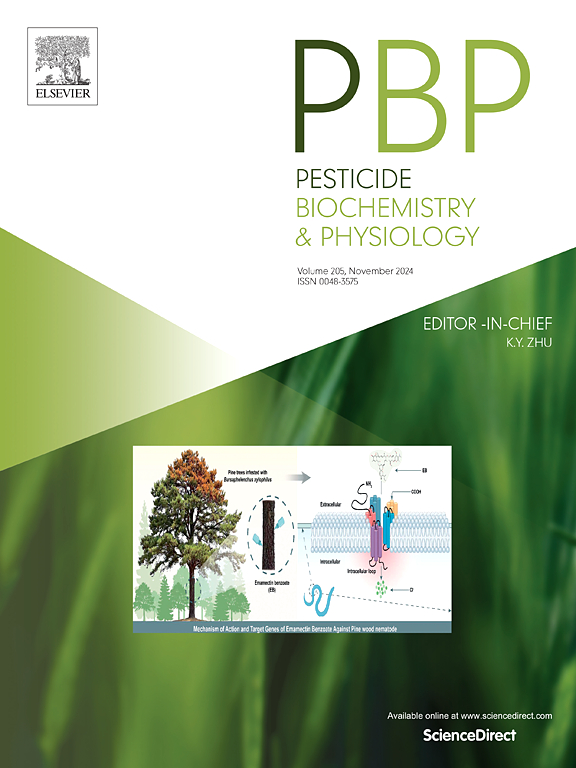吲哚和香兰素通过α-羟基酮连接的分子杂交发现新的PVY细胞间运输抑制剂
IF 4.2
1区 农林科学
Q2 BIOCHEMISTRY & MOLECULAR BIOLOGY
引用次数: 0
摘要
马铃薯Y病毒(PVY)显著降低了经济上重要的茄科作物的产量,而市场上有效抗病毒药物的有限供应突出了探索创新抗病毒先导结构的必要性。在此,我们揭示了一种新的类似病毒的化合物,它是由天然吲哚和香兰素分子杂交设计的。在生物实验中,大多数杂化衍生物都表现出抗pvy的特性。其中化合物C7对PVY的灭活效果较好,中位效浓度(EC50)为121.3±4.9 μg/mL,显著低于对照利巴韦林(EC50 = 245.6±10.3 μg/mL)和vanisulfane (EC50 = 351.4±4.8 μg/mL)。分子对接结果表明PVY衣壳蛋白(CP)的Arg214与C7之间形成了稳定的氢键。结合体外和体内实验,Arg214被鉴定为调节PVY在宿主体内系统入侵的功能残基。共聚焦显微镜技术提供的进一步证据支持C7作为病毒粒子细胞间运动的潜在抑制剂。这项研究为化学阻断病毒细胞间运动提供了一个可用的先导结构。本文章由计算机程序翻译,如有差异,请以英文原文为准。
Molecular hybridization of indoles and vanillins via α-hydroxyketone linking for discovering new inhibitor of PVY intercellular traffic
Potato virus Y (PVY) significantly reduces yield in economically important Solanaceae crops, while the limited availability of effective antiviral agents in the market highlights the necessity for exploring innovative antiviral lead structures. Herein, we disclose a new analogue of virucidal compounds, which are designed by molecular hybridization of natural indole and vanillin moieties. Most hybrid derivatives under bio-assay exhibit anti-PVY properties. Compound C7, in particular, shows superior inactivating effects to PVY, with a median effect concentration (EC50) of 121.3 ± 4.9 μg/mL, which is significantly lower than that of controls ribavirin (EC50 = 245.6 ± 10.3 μg/mL) and vanisulfane (EC50 = 351.4 ± 4.8 μg/mL). The molecular docking result indicates formation of stable hydrogen-bonding between Arg214 of PVY capsid protein (CP) and C7. Combining in vitro and in vivo assays allows Arg214 to be identified as a functional residue modulating PVY systemic invasion in hosts. Further evidence provided by confocal microscope technique supports that C7 behaves as a potential inhibitor of virion intercellular movement. This study contributes an available lead structure for chemical blocking of viral cell-to-cell movement.
求助全文
通过发布文献求助,成功后即可免费获取论文全文。
去求助
来源期刊
CiteScore
7.00
自引率
8.50%
发文量
238
审稿时长
4.2 months
期刊介绍:
Pesticide Biochemistry and Physiology publishes original scientific articles pertaining to the mode of action of plant protection agents such as insecticides, fungicides, herbicides, and similar compounds, including nonlethal pest control agents, biosynthesis of pheromones, hormones, and plant resistance agents. Manuscripts may include a biochemical, physiological, or molecular study for an understanding of comparative toxicology or selective toxicity of both target and nontarget organisms. Particular interest will be given to studies on the molecular biology of pest control, toxicology, and pesticide resistance.
Research Areas Emphasized Include the Biochemistry and Physiology of:
• Comparative toxicity
• Mode of action
• Pathophysiology
• Plant growth regulators
• Resistance
• Other effects of pesticides on both parasites and hosts.

 求助内容:
求助内容: 应助结果提醒方式:
应助结果提醒方式:


